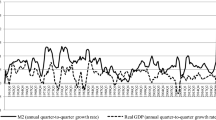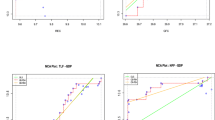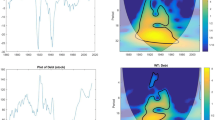Abstract
This paper aims to test a causal nexus between capacity utilization and inflation in the United States for the period from January 1969 to June 2017. Given the non-validity of the constant-parameter linear model (i.e., standard linear Granger causality) in attendance of nonlinearities and structural breaks, we use wavelets to provide a more general picture of the link between the U.S. capacity utilization and U.S. inflation in both time and frequency domains. The findings indicate a positive co-movement between the variables, mainly at high frequencies (shorter term). In addition, we do find evidence of a significant bi-causal relationship between capacity utilization rate and inflation per different frequency, whereas standard linear Granger causality detects a unidirectional link from inflation to capacity utilization. In general, our findings suggest a notable implication for policy makers that are in contradiction to the view of recent scholars regarding deterioration in the inflation–utilisation nexus.
Similar content being viewed by others
Notes
One might apply a nonparametric causality test with the ability to capture the nonlinearities and changes in regimes; however, the problem arises from a restriction to only the time domain. Hence, this approach cannot discern whether the causality between variables exists in the short-, medium- or long-run. Moreover, nonparametric tests are much more restricted than the wavelet, because the former is not time-varying, unlike phase differences in the latter.
A traditional method that examines periodicities in the frequency domain and implicitly assumes that the underlying processes are stationary in time; for details, see Aguiar-Conraria et al. (2008).
The self-similarity property implies a long-term dependence between the series (i.e., They have a similar shape, like cycle).
Here, \(L^2({\mathbb {R}})\) shows a space of finite energy functions. For more details, see Aguiar-Conraria et al. (2008, p. 2868).
If \(|s|<1\), then the mother wavelet \(\psi (t)\) is compressed, whereas \(|s|>1\) exposes that the mother wavelet \(\psi (t)\) is stretched across frequencies.
As is clear from the equation, \(C_{\psi }\) is a constant for each given mother wavelet and is, therefore, called the “admissibility constant”.
Because the Fourier frequency is defined by \(f(s) = \frac{\omega _0}{2\pi s} \), we can obtain the best conversion from the wavelet scale to the Fourier frequency f.
Some studies such as Finn (1996) have shown that fuel prices have a negative impact on capacity utilisation, whereas the core CPI excludes the more volatile categories of food and energy prices.
Available at https://fred.stlouisfed.org.
A log transformation has been made for the capacity utilisation rate to correct the potential heteroscedasticity and dimensional differences between the series.
According to the reasoning of Cavaliere (2005) and Cavaliere and Xu (2014), conventional unit root–critical values are not appropriate for bounded series. Moreover, they argue that conventional unit root critical values are inappropriate for series influenced by a control policy. Capacity utilisation is influenced by both of these rationales to some extent, such that it is bounded by construction between 0 and 100 and indirectly targeted by policy makers as an analogue of directly targeted labour unemployment, which consequently binds capacity utilisation even more than the simple 0 and 100 values. Hence, following Ahmed and Cassou (2017), we conduct the Cavaliere and Xu (2014) simulation-based ADF unit root test for the log of capacity utilisation rate. Under the constant term scenario, our simulated critical value at 5% level is \(-\,3.125\), where adopting this new adjusted critical value results in non-rejection of the null of a unit root for capacity utilisation.
The standard Granger test is based on asymptotic distribution theory; however, in the presence of the nonstationary variables of the VAR model, results do not follow the formal asymptotic chi-squared distribution under the null hypothesis (Granger and Newbold 1974). Transforming the variables by differencing can be a remedy for this problem, but this will lead to loss of long-run information. For details, see Hacker and Hatemi-J (2006).
For brevity, we do not report the LM test for serial independence. The results are available upon request from the authors.
Our results agree with the recent calls made by economists in the popular press, which proposed the desirability of inflation inducement by the Federal Reserve Bank.
References
Addison, P. S. (2017). The illustrated wavelet transform handbook: Introductory theory and applications in science, engineering, medicine and finance. Boca Raton: CRC Press.
Aguiar-Conraria, L., Azevedo, N., & Soares, M. J. (2008). Using wavelets to decompose the time- frequency effects of monetary policy. Physica A: Statistical Mechanics and its Applications, 387(12), 2863–2878.
Aguiar-Conraria, L., & Soares, M. J. (2014). The continuous wavelet transform: moving beyond uni- and bivariate analysis. Journal of Economic Surveys, 28(2), 344–375.
Ahmed, M. I., & Cassou, S. P. (2017). Threshold cointegration between inflation and US capacity utilization. Applied Economics, 49(3), 289–302.
Aiyagari, S. R. (1994). On the contribution of technology shocks to business cycles. Quarterly Review-Federal Reserve Bank of Minneapolis, 18(1), 22.
Antonakakis, N., Chang, T., Cunado, J., & Gupta, R. (2018). The relationship between commodity markets and commodity mutual funds: A waveletbased analysis. Finance Research Letters, 24, 1–9.
Bagshaw, K. B. (2015). Assessing the capacity strategic options on capacity utilization of manufacturing firms in Rivers State, Nigeria. International Journal of Business and Social Science, 6(10), 67–79.
Bai, J., & Perron, P. (2003). Computation and analysis of multiple structural change models. Journal of Applied Econometrics, 18(1), 1–22.
Bansak, C., Morin, N., & Starr, M. (2007). Technology, capital spending, and capacity utilization. Economic Inquiry, 45(3), 631–645.
Bauer, P. W. (1990). A reexamination of the relationship between capacity utilization and inflation. Economic Review-Federal Reserve Bank of Cleveland, 26(3), 2.
Björnberg, D. (2017). Wavelets: Introduction and applications for economic time series. U.U.D.M. Project Report 2017:20.
Bloomfield, P. (2004). Fourier analysis of time series: An introduction. New York: Wiley.
Brayton, F., Roberts, J., & Williams, J. (1999). What’s happened to the Phillips curve? FEDS Working Paper No. 99-49. Available at SSRN: https://ssrn.com/abstract=190852, https://doi.org/10.2139/ssrn.190852.
Broock, W. A., Scheinkman, J. A., Dechert, W. D., & LeBaron, B. (1996). A test for independence based on the correlation dimension. Econometric Reviews, 15(3), 197–235.
Canarella, G., Fang, W., Miller, S. M., Pollard, S. K. (2008). Is the Great Moderation ending? UK and US evidence.. Economics Working Papers. 200824. https://opencommons.uconn.edu/econ_wpapers/200824.
Cavaliere, G. (2005). Limited time series with a unit root. Econometric Theory, 21(5), 907–945.
Cavaliere, G., & Xu, F. (2014). Testing for unit roots in bounded time series. Journal of Econometrics, 178, 259–272.
Cecchetti, S. G. (1995). Inflation indicators and inflation policy. NBER Macroeconomics Annual, 10, 189–219.
Corrado, C., & Mattey, J. (1997). Capacity utilization. Journal of Economic Perspectives, 11(1), 151–167.
Crotty, J. (2002). Why there is chronic excess capacity. Challenge, 45(6), 21–44.
Daubechies, I. (1988). Orthonormal bases of compactly supported wavelets. Communications on Pure and Applied Mathematics, 41(7), 909–996.
Daubechies, I. (1992). Ten lectures on wavelets (Vol. 61). Philadelphia: SIAM.
De Kock, G. S., & Nadal-Vicens, T. (1996). Capacity utilization–inflation linkages: A cross-country analysis. Retrieved from.
Dexter, A. S., Levi, M. D., & Nault, B. R. (2005). International trade and the connection between excess demand and inflation. Review of International Economics, 13(4), 699–708.
Dickey, D. A., & Fuller, W. A. (1979). Distribution of the estimators for autoregressive time series with a unit root. Journal of the American Statistical Association, 74(366a), 427–431.
Dotsey, M., & Stark, T. (2005). The relationship between capacity utilization and inflation. Federal Reserve Bank of Philadelphia Business Review, 8–17.
Elliott, G., Rothenberg, T. J., & Stock, J. H. (1992). Efficient tests for an autoregressive unit root. Cambridge, MA: National Bureau of Economic Research.
Embrechts, P., Herzberg, A. M., Kalbfleisch, H. K., Traves, W. N., & Whitla, J. R. (1995). An introduction to wavelets with applications to Andrews; plots. Journal of Computational and Applied Mathematics, 64(1–2), 41–56.
Emery, K. M., & Chang, C. (1997). Is there a stable relationship between capacity utilization and inflation? Economic Review - Federal Reserve Bank of Dallas, pp. 14–20. Retrieved from https://proxy.queensu.ca/login?qurl=https%3A%2F%2Fsearch.proquest.com%2Fdocview%2F219384189%3Faccountid%3D6180.
Fang, W., & Miller, S. (2008). The great moderation and the relationship between output growth and its volatility. Southern Economic Journal, 74(3), 819–838. Retrieved May 20, 2020, from www.jstor.org/stable/20111998
Farge, M. (1992). Wavelet transforms and their applications to turbulence. Annual Review of Fluid Mechanics, 24(1), 395–458.
Finn, M. (1995). Is ’high’ capacity utilization inflationary? FRB Richmond Economic Quarterly, 81, 1–16.
Finn, M. G. (1996). A theory of the capacity utilization/inflation relationship. FRB Richmond Economic Quarterly, 82, 67–86.
Gamber, E. N., & Hung, J. H. (2001). Has the rise in globalization reduced US inflation in the 1990s? Economic Inquiry, 39(1), 58–73.
Gao, R. X., & Yan, R. (2010). Wavelets: Theory and applications for manufacturing. Berlin: Springer.
Garner, C. A. (1994). Capacity utilization and US inflation. Economic Review-Federal Reserve Bank of Kansas City, 79(4), 5.
Goffe, W. (1994). Wavelets in macroeconomics: An introduction. In D. Belsley (Ed.), Computational techniques for econometrics and economic analysis (pp. 137–149). Dordrecht: Kluwer Academic.
Gogas, P., Gupta, R., Miller, S. M., Papadimitriou, T., & Sarantitis, G. (2017). Income inequality: A state-by-state complex network analysis. Physica A: Statistical Mechanics and its Applications. Available at SSRN: https://ssrn.com/abstract=2623750; or https://doi.org/10.2139/ssrn.2623750.
Gordon, R. (1994). Inflation, wages, and productivity. Testimony prepared for the House Budget Committee, June, 8.
Goupillaud, P., Grossmann, A., & Morlet, J. (1984). Cycle-octave and related transforms in seismic signal analysis. Geoexploration, 23(1), 85–102.
Granger, C. W. (1969). Investigating causal relations by econometric models and cross-spectral methods. Econometrica: Journal of the Econometric Society, 37(3), 424–438.
Granger, C. W. (1986). Developments in the study of cointegrated economic variables. Oxford Bulletin of Economics and Statistics, 48(3), 213–228.
Granger, C. W., & Newbold, P. (1974). Spurious regressions in econometrics. Journal of Econometrics, 2(2), 111–120.
Grinsted, A., Moore, J. C., & Jevrejeva, S. (2004). Application of the cross wavelet transform and wavelet coherence to geophysical time series. Nonlinear Processes in Geophysics, 11(5/6), 561–566.
Grossmann, A., & Morlet, J. (1984). Decomposition of Hardy functions into square integrable wavelets of constant shape. SIAM Journal on Mathematical Analysis, 15(4), 723–736.
Haar, A. (1910). Aur theorie der orthogonalen Funcktionensysteme. Mathematische Annalen, 69, 331–371.
Hacker, R. S., & Hatemi-J, A. (2006). Tests for causality between integrated variables using asymptotic and bootstrap distributions: Theory and application. Applied Economics, 38(13), 1489–1500.
Johansen, S. (1988). Statistical analysis of cointegration vectors. Journal of Economic Dynamics and Control, 12(2–3), 231–254.
Johansen, S. (1991). Estimation and hypothesis testing of cointegration vectors in Gaussian vector autoregressive models. Econometrica: Journal of the Econometric Society, 59(6), 1551–1580.
Kwiatkowski, D., Phillips, P. C., Schmidt, P., & Shin, Y. (1992). Testing the null hypothesis of stationarity against the alternative of a unit root: How sure are we that economic time series have a unit root? Journal of Econometrics, 54(1–3), 159–178.
Le, T.-H., & Chang, Y. (2015). Effects of oil price shocks on the stock market performance: Do nature of shocks and economies matter? Energy Economics, 51, 261–274.
Li, X.-L., Chang, T., Miller, S. M., Balcilar, M., & Gupta, R. (2015). The co-movement and causality between the US housing and stock markets in the time and frequency domains. International Review of Economics Finance, 38, 220–233.
Lodder, S. (2009). Single-trial classification of an EEG-based brain computer interface using the wavelet packet decomposition and cepstral analysis (Doctoral dissertation, Stellenbosch: University of Stellenbosch).
Loh, L. (2013). Co-movement of Asia-Pacific with European and US stock market returns: A cross-time-frequency analysis. Research in International Business and Finance, 29, 1–13.
MacKinnon, J. G., Haug, A. A., & Michelis, L. (1999). Numerical distribution functions of likelihood ratio tests for cointegration. Journal of Applied Econometrics, 14, 563–577.
Mallat, S. (1998). A wavelet tour of signal processing. New York: Academic Press.
McElhattan, R. (1978). Estimating a stable-inflation capacity-utilization rate. Economic Review (Fall), 20–30.
McElhattan, R. (1985). Inflation, supply shocks and the stable-inflation rate of capacity utilization. Economic Review (Win), 45–63.
Nahuis, N. J. (2003). An alternative demand indicator: The “non-accelerating inflation rate of capacity utilization”. Applied Economics, 35(11), 1339–1344.
Ng, S., & Perron, P. (2001). Lag length selection and the construction of unit root tests with good size and power. Econometrica, 69(6), 1519–1554.
Perron, P., & Ng, S. (1996). Useful modifications to some unit root tests with dependent errors and their local asymptotic properties. The Review of Economic Studies, 63(3), 435–463.
Phillips, P. C., & Perron, P. (1988). Testing for a unit root in time series regression. Biometrika, 75(2), 335–346.
Ramsey, J., & Lampart, C. (1998a). Decomposition of economic relationships by time scale using wavelets: money and income. Macroeconomic Dynamics, 2, 49–71.
Ramsey, J., & Lampart, C. (1998b). The decomposition of economic relationships by time scale using wavelets: expenditure and income. Studies in Nonlinear Dynamics and Econometrics, 3, 23–42.
Ramsey, J. B. (2002). Wavelets in economics and finance: Past and future. Studies in Nonlinear Dynamics & Econometrics. https://doi.org/10.2202/1558-3708.1090.
Roueff, F., & Von Sachs, R. (2011). Locally stationary long memory estimation. Stochastic Processes and Their Applications, 121(4), 813–844.
Schleicher, C. (2002). An introduction to wavelets for economists. Bank of Canada.
Shapiro, M. D., Gordon, R. J., & Summers, L. H. (1989). Assessing the Federal Reserve’s measures of capacity and utilization. Brookings Papers on Economic Activity, 1989(1), 181–241.
Soytas, U., & Sari, R. (2006). Can China contribute more to the fight against global warming? Journal of Policy Modeling, 28(8), 837-846.
Stock, J. H., & Watson, M. W. (1999). Forecasting inflation. Journal of Monetary Economics, 44(2), 293–335.
Tiwari, A. K., Dar, A. B., & Bhanja, N. (2013). Oil price and exchange rates: A wavelet based analysis for India. Economic Modelling, 31, 414–422.
Toda, H. Y., & Yamamoto, T. (1995). Statistical inference in vector autoregressions with possibly integrated processes. Journal of Econometrics, 66(1–2), 225–250.
Torrence, C., & Compo, G. P. (1998). A practical guide to wavelet analysis. Bulletin of the American Meteorological Society, 79(1), 61–78.
Torrence, C., & Webster, P. J. (1999). Interdecadal changes in the ENSO–monsoon system. Journal of climate, 12(8), 2679–2690.
Author information
Authors and Affiliations
Corresponding author
Additional information
Publisher's Note
Springer Nature remains neutral with regard to jurisdictional claims in published maps and institutional affiliations.
Rights and permissions
About this article
Cite this article
Bahramian, P., Saliminezhad, A. Does Capacity Utilization Predict Inflation? A Wavelet Based Evidence from United States. Comput Econ 58, 1103–1125 (2021). https://doi.org/10.1007/s10614-020-09990-4
Accepted:
Published:
Issue Date:
DOI: https://doi.org/10.1007/s10614-020-09990-4









